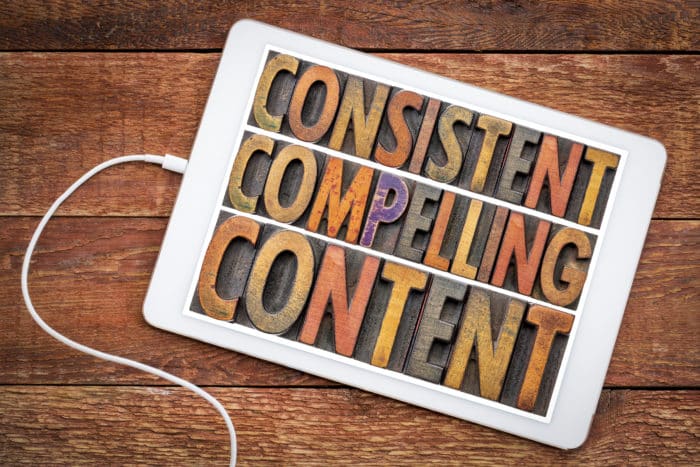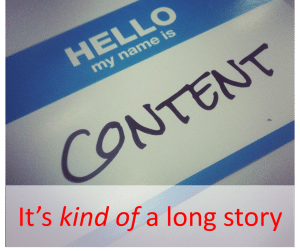
You’ve Heard Of Big Data But What Is Big Content?

The term Big Content has been used in a couple of different ways by some big names and influential media outlets. So I thought I would try and provide an overview and some additional thoughts of my own to help answer:
What is Big Content?
Almost 2 years ago, Gartner’s Craig Roth brought up the idea of Big Content. To Craig, Big Content is the unstructured step-child of Big Data and represents the explosion of tweets, vines, blogs and all other content that we are now creating at increasing rates.
In a similar way, Idio suggested that this was an important consideration because like Big Data, Big Content needs a strategy, an analytic model to support it and a process to manage the operations of the content marketing hub.
Then Moz decided to take the term away from the volume definition (lots of content) and more in the direction of the value of the content or the depth. They defined Big Content as content that takes a lot of effort, is not necessarily long-form and also breaks the mold of some traditional content types.
They also suggested that the effort was worth it, in the form of having a longer shelf-life and longevity, because it creates a barrier to entry for your competitors and because it typically rides the wave of a big idea.
Going Long On Content
Now the conversation is shifting to long form content. Business Insider used 21,000 words on an in-depth profile of Yahoo CEO Marissa Mayer. Huffington Post has won a Pulitzer prize and even BuzzFeed has added political coverage.
There are some obvious and proven SEO benefits of long form content.
But there are some pretty big risks in this approach as shown by Jonathan Mahler from The New York Times recently that long-form is bad form.
So this begs the question: when do you decide to invest the time and effort to go long on content?
I think anyone who studies the latest trends in content production and looks into who reads what, when and where will see that we can’t just create short form content, tweets and vines.
Our customers will read and consume long form content as long as it meets the 2 needs of ALL content: is it interesting (storytelling) and does it meet a need (inform, educate or entertain).
In somewhat of an oxymoron, long form content would be one of the by-products of a lean content approach that identifies new content ideas, produces and publishes the content, and then measures and analyzes what works.
My guidance would be that all content production should invest some percentage of time and effort in long form content. The percentage should be big enough that you can generate enough pieces to gain some real insights into what works and also to move the needle on SEO.
But you should also be careful not to extend too far that you’re not meeting the consistent needs of the market in the form of blogs, tweets, vines, and lists.
Is your business looking into Big Content? Looking for more traffic to your website with weekly blog articles, a full year content plan, and monthly reporting? Set up a quick call, so we can get started today…
And if you are looking for more examples, here are Unbounce’s Top 10 Big Content Resources of 2013.







This is a great article. I’m relieved that there is emphasis on quality. Bad content is bad for your brand, no matter if it’s short OR long. And, thanks for the link to the Top 10 Online Content Resources of 2013.
I say just write for your readers and native to the platform. If your content is contextually to the platform and appeals to the reader self-interest it will get read, shared, linked too and ranked.
You got it Jennifer! This is an interesting topic and hasn’t really hit the radar for most people yet.
I think you are absolutely right Patrick, Customer-focused Content and context are both important.
Interesting how buzzwords can cross industries. I’ll say that I strongly dislike “Big Content” used in the context of content marketing because it’s not really got much to do with it. Big Data is a concept that sorta lumps business intelligence, analytics, and a few other technical bits I don’t completely understand into a single concept to get across the idea that there is a LOT of data out there. It’s structured data — rows in a database — and relatively easy to crunch through with enough brute force and new tools like Hadoop and a host of others. You can write queries to extract what you want to find — how many of my customers are male, between the ages of 25 and 45, and bought workout clothes between December and January. Making sense of that and applying it to coupons, in-store offers, stocking, staffing, etc. is a whole ‘nother thing.
Big Content is the unstructured step brother of Big Data. Unstructured would be this. Or a tweet. Or a business report. Or an email. Or a website. Or customer contact logs. There’s a different set of tools — loosely called content analytics — that can semantically parse content for ediscovery or to analyze customer sentiment or to identify trends or just plain to find that document you wrote two years ago that you filed who knows where and could use for a new project.
Where these two technology trends will start to overlap with content marketing is in using both sets of tools to figure out what customers want and then creating content that prods them in the desired direction. But both of these trends are separate from content marketing.
And I couldn’t agree more with Patrick; long, short, or in between, write for your readers.
Wow, thanks Bryant. That’s a post right there and I really appreciate it. I also feel like it does not really fit. I think long-form content is emerging as a trend based on a couple of factors: 1) google is loving it 2) SOME people want it and 3) many are tired of the same old formats. So I do believe it is a trend (whatever we call it) if not a buzzword we want to use.
Good article,
My experience of hosting and operating a business-focused Twitter account for the past 4 years (@Hoovers_Energy) is that 99% of the Twitter items I receive are 140-or-less character introductions to long form text presentations. They basically say “Hey, check out this article!”
The short form Twitter venue is the marketer, sales person, and door opener for “old school” long-form content.
That’s a great point Stuart. It’s like the introduction. But there is always the need to tell the bigger story.
I wasn’t trying to argue against the turn towards longer-form content (did we ever really get away from that other than via folks eager to hang out a guru, I gots your answers shingle?) Absolutely agree that long-form content continues to have a place (just like it always has). Reading articles that say “your content MUST BE SHORT” is like fingernails on a blackboard. If it’s good and useful, there’s a good chance your audience will read it.
My main point is that there is a technical meaning to Big Content that content marketing folks have taken and mangled because getting that technology right is crazy hard. Just irks me. Spent too long as an editor being bombarded with vendor buzz words and it’s left me curmudgeonly.
Point well taken Bryant. Want to get me curmudgeonly? Just ask me to create a viral video 😉
Does Big Content stand for Long Content or Quality Content?
A well-designed infographics with a lot of first hand data may not be a very long content, but it’s definitely very expensive to produce … and probably giving more value to the reader than a 1,000 word article.
In my mind Big Content describes your flagship content. You may create a lot of short and easy-reading content that derives from it, but at the end, these are just breadcrumbs to attract and engage readers to spend time “consuming” your Big content.
Thanks Jeremy, I think you’re right. It’s not necessarily long but it definitely adds more value.
Many thanks Michael for the post! Although I have my own set of questions and insights for the topic. I infer from your post that long content can be of strategic importance to a person or company if it is written by a good writer who can engage, entertain & educate the respective audience; well I’m in favor of this if that was one of the motivation. Now my dilemma is with the advent of internet everybody is a writer and most of them are writing on almost everything so you never know when someone strikes a chord. A story in today’s world can be covered by not only reporters but also by equally interested, self proclaimed & responsible citizen journalists, bloggers, viners, rediters et. al in their own way & can be shared with the audience effectively. with so many different views available what is the point on sticking with one persons’ story which will be of long content rather going for stories compiled by different people with a shot content. My next point is with the technology converging & disrupting everybody’s life, a person is just not interested in a story or content which deals with this profession and would like to know & follow different sectors as he sets his foot in the age of lateral thinking.
Hi Vijay, Let me try and take your points one by one:
1. We live in a world that values short, visual content (pictures on instagram, tweets, etc). But sometimes, people want to “lean back” and read a longer, well-thought, well-written perspective on an important topic. This is not only good for reaching those interested, it is also valued by the search engines and can allow you to reach a new and different audience.
2. Everyone is a writer. So you have 2 choices: enter the conversation and write about your own point of view or sit back and watch the conversation as a bystander. Taking the latter approach adds no value to anyone other than you as the bystander.
3. I’m not sure I get your point on technology. Good content is only good if someone is interested in it. Businesses should aim to create more content that their audience is interested in and stop creating the stuff no one wants.
Hope that helps!
Great insights! Businesses need to spend more focus on creating high quality, in-depth content. Studies have shown that the more popular posts tend to be longer and give the reader something they can take away and put into place for their own needs. Thanks again for sharing!
I think some of you are missing the point, “big content” is certainly here and you are not realizing that it is actually structured and not an “unstructured mess” that needs an ETL/MDM normalization engine and hadoop to structure it. Most marketers understands that consumer interact with “content” and it is this interaction that builds the initial intelligence (analytics) of what customers thinks/perceives about the brand. Early stage digital tagging, content centralization and DMP/DSP all leverage content associations and lots of information is collected, location, platform, interaction, time, date, product, media channel, personal details and content relationships. The new enterprise “omni-channel content platforms” understand these “semantic” relationships and start building a map of the consumers interaction with the brands content, after-all, consumers don’t interact with CRM or Analytics, these are just the recording the outcomes of the journey. I am also not talking about content publishing or the creative concepts, but let me tell you this, if I had a solution that enables me to spin my reporting structures from an image to a person to a location and build the report the consumer experiences and relevance I have a very powerful in-line analytics tool that I can optimize to generate the next content interaction with that consumer. Business intelligence is getting baked into content, something if you are all observing that GoPro is doing right now with all of their consumer generated content to a level that means that the GoPro brand is a brand that “brands itself” through utilization of its customers content and not through outbound marketing initiatives. GoPro uses known metrics of content interaction to drive content experiences to it’s customers, it’s exciting, generates a spark in the consumers mind and initiates a brand association that gets tracked all the way through to the purchasing of the product.
Thanks Karly. Quality is non-negotiable and I am seeing more brands (and publishers) focus on this in-depth style of reporting. I think there needs to be a mix of quick-hit, helpful how-to’s and some in-depth coverage of important topics.
Wow David that is really cool. I’m a big fan of GoPro but had no idea the depth they were going.